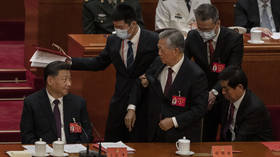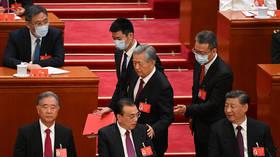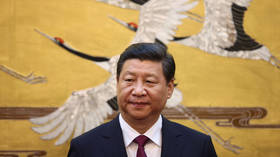Hu Jintao speculation is the latest instance of the media gaslighting the public about China

During the 20th national party congress of the Communist Party of China, media erupted over a brief scene whereby the country’s former leader, Hu Jintao (2002-2012), appeared to be removed from the podium, having been seated next to Xi Jinping. Chinese state media said he was not feeling well, but coverage in the West quickly brought up the word ‘purge’, deliberately drawing contrast with his more collective form of leadership compared to Xi’s ‘one-man’ centralization.
The idea that a former national leader, now 79 years of age, was publicly ‘purged’ on live television footage of an ultra-important political event, is nothing short of ridiculous. Yet, this is where we are today in terms of coverage of contemporary China. Even well over a week after the supposed incident, media articles continue to pour in, speculating on the former general secretary’s fate, invoking paranoia and negativity towards China and brushing off the logical explanation that he could have left the event due to “ill health.”
The attitude the Western media have shown towards the Hu Jintao ‘incident’ is representative of a broader culture of gaslighting in respect to all things China. That being, with any opportunity they can find, Western corporate news organizations will actively blow them up to create a prolonged course of negative, speculative and sensational coverage which they drag out again and again, with the goal of waging a ‘public opinion’ war against Beijing. In this toxic atmosphere, China is targeted for small details and is subjected to scrutiny that other countries do not get.
Since the United States started escalating its campaign against China, a public opinion war has accompanied it with the goal of advancing American political objectives by manipulating global conversation on Beijing. A quick look at public opinion polling in Western countries shows how devastating this campaign led by Washington has been. While journalists and think-tankers enjoy affirming the decline in positive opinions on China as vindication of their views of how China, and Xi Jinping’s actions, are “bad”, the reality is that there has been a concentrated and organized weaponization of public opinion against China by US-associated journalists, politicians, and pundits.
And part of this campaign involves this endless pursuit of gaslighting every small detail into prolonged controversy and drama. Some recent (but not exhaustive) examples of this include how endless speculation over the origins of Covid-19 were used to weaponize conspiracy theories regarding a supposed lab leak in China – a matter that was pushed by the US State Department and the media – the purported public disappearance of tennis player Peng Shuai, the recent scuffle outside of the Chinese Embassy in Manchester, disputes in regards to Taiwan, the impact of China’s zero-Covid policies, Chinese rocket debris falling from space, the list goes on.
What all these stories have in common is how they do not simply happen and then die. They are dragged on again and again continuously until the next item in the news cycle arises. What onlookers need to recognize about this pattern of reporting is that agenda-driven journalism such as this is ultimately selective and seeks to manipulate public opinion through what it chooses to highlight and what it does not choose to highlight. Any speculation which purports opposition to China in any way will be given maximum coverage, deliberately. The same cannot be said about other countries. Why, for example, are some human rights activists, or protest events, given publicity, but not others? Why are some causes deemed more ‘worthy’?
In addition to this, what the Hu Jintao debacle also helps us understand is how discursive fear and the ‘public imagination’ of Communism is also used as a journalistic tool in order to transform ‘speculation’ into a political weapon. The media plays upon the public assumption of secrecy, brutality and paranoia of China in order to twist very normal situations to imply worst-case scenarios. It is through this that the assumption that Covid-19 could not have had a ‘natural explanation’ gained so much legitimacy. In such a mindset, each and every little thing is seen in the context of a broader and sinister conspiracy theory with a hidden Communist agenda in it. This type of discourse has also allowed the fear and paranoia of ‘Chinese influence’ to proliferate, creating consent for containment-related policies.
One example is the branding of Huawei as a national security threat so that it may be excluded from 5G networks. Even though Huawei was in the networks of Western countries for over a decade, you might note that it wasn’t a threat until it suddenly was, and that’s how the manipulation works.
Therefore, the gaslighting regarding the whereabouts of an elderly man is nothing more than deliberate manipulation aimed at weaponizing negative sentiment against China and casting a shadow over the 20th party congress, because they don’t want Beijing to establish its own narrative concerning the event under any circumstances.
The statements, views and opinions expressed in this column are solely those of the author and do not necessarily represent those of RT.














